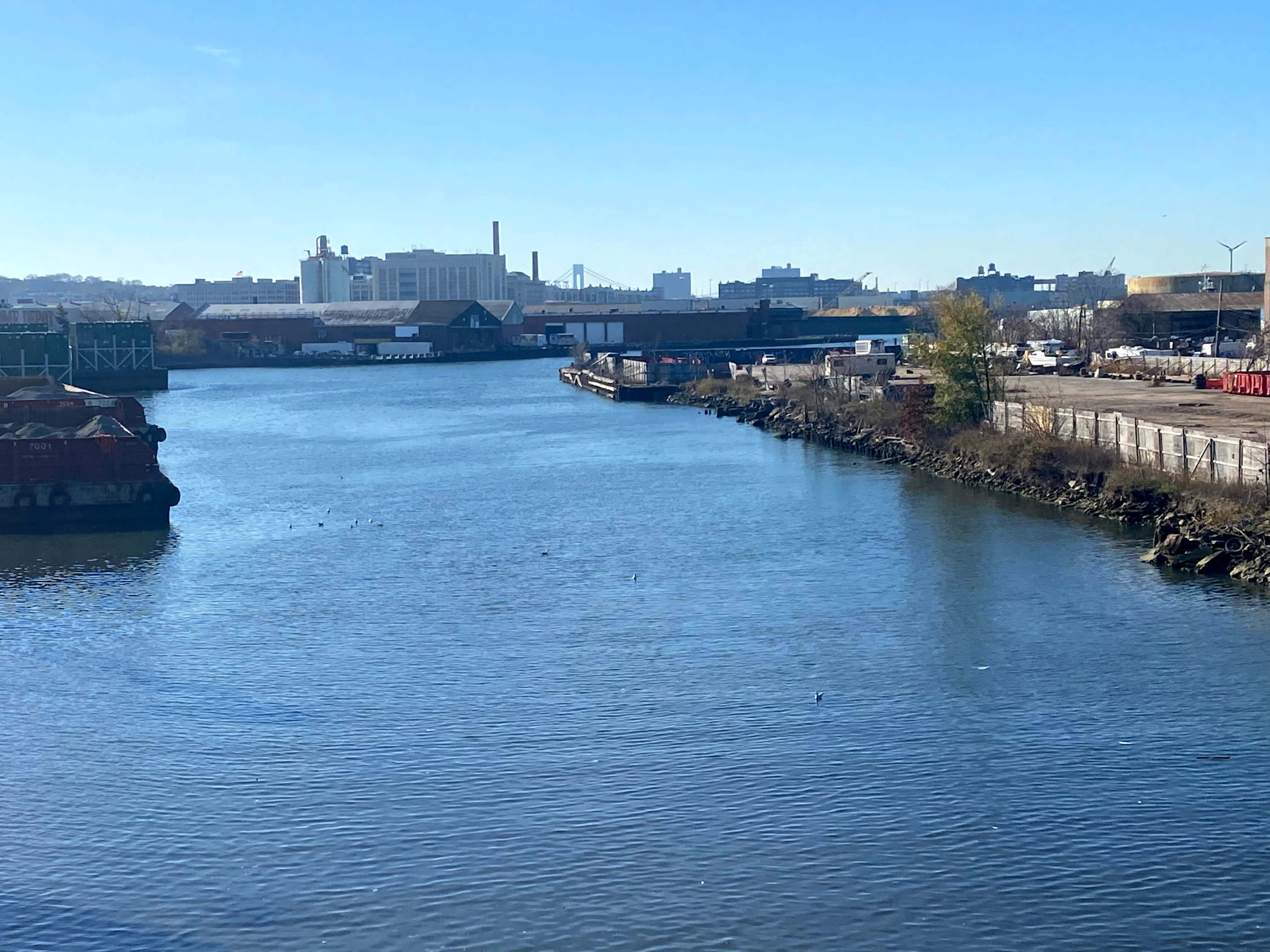After more than 160 years as a repository of human and industrial waste, the Gowanus Canal is leaving its toxic legacy behind—or under. Last month marked a milestone in the Superfund cleanup of the waterway, as the bottom of the canal north of the 3rd Street Bridge was successfully injected with a five-foot layer of cement in a process known as in-situ stabilization. The procedure, overseen by the Environmental Protection Agency (EPA), follows dredging works done earlier this year and will prevent remaining pollutants in the canal’s sediment from recontaminating the water above.
The news was communicated to members of the Gowanus Canal Advisory Group by Christos Tsiamis, the EPA engineer leading the remediation, during an October 26 virtual meeting. “This is globally groundbreaking work,” added EPA counsel Brian Carr, noting that in-situ stabilization had never been attempted in saltwater before. The stretch between 3rd and 9th Streets will be stabilized in about a month’s time, once the EPA runs tests and completes other works at the top of the canal, said Tsiamis.
In the meantime, the brick-by-brick dismantling of 234 Butler Street will begin in the coming weeks.
The building’s facade will be reassembled following the construction of an 8-million-gallon retention tank that will stop sewage from pouring into the Gowanus Canal in the future. The EPA had previously ordered New York City to begin construction of the tank back in March, after repeated delays were denounced by the advisory group. The tank is slated for completion around July 2023.
Water under the bridge
Tensions between federal and state officials had been escalating earlier this year over the remediation of Public Place, a heavily contaminated industrial site along the canal on which the city envisions an affordable housing complex it’s touting as Gowanus Green, a park, and a public school.
During a now-infamous virtual meeting in December of last year, Tsiamis warned the advisory group that the remedy, planned by utility company National Grid and overseen by New York State’s Department of Environmental Conservation (DEC), would not be sufficiently protective of human health and would jeopardize the EPA’s cleanup of the canal. This led to a series of heated exchanges at subsequent meetings with the advisory group and to terse words exchanged via official correspondences. Cooler heads seemed to have prevailed in April with the issuing of a joint EPA-DEC pledge of cooperation in addressing the issues raised.
Both agencies have made good on that promise, said Tsiamis. Members of EPA management and technical personnel have met virtually with their state, city, and National Grid counterparts three times since August to discuss the challenges of remediating Public Place. “The discussions that we had have been satisfactory to EPA. A good outcome to those discussions [will address] EPA’s concerns for that site as an integral part of Superfund.”
The EPA is currently reviewing proposals made by DEC and Gowanus Green developers for the installation of a vapor intrusion barrier to protect future residents from the toxic chemicals that continually rise from the site. Details on the barrier’s lifespan, material, and future monitoring plan will be revealed at a later date, Tsiamis said. Solutions to other health and environmental hazards at Public Place, such as dealing with contaminated runoff spilling back into the canal and safely extracting the buried coal tar that will accumulate at the waterfront for decades to come are also forthcoming, he added. How to effectively contain the underground coal tar and prevent it from migrating off-site will be the subject of discussions at a fourth meeting between federal and state officials this month.
Whose streets?
As the cleanup of the Gowanus Canal steadily advances, Brad Vogel of Voice of Gowanus, a local organization that opposes the city’s rezoning plan for the neighborhood, stressed the importance of giving residents a say in shaping the waterfront and public access to it. The upcoming installation of a canal-side bulkhead at the end of Degraw Street presents such an opportunity, he said. Vogel called for the EPA to arrange a meeting with the city agencies responsible for developing the streetscapes around the waterway. Though the EPA supports the community’s right to shape their environment for their benefit, fulfilling that request would be outside the scope of the federal agency, which mainly concerns itself with overseeing and protecting the integrity of the Gowanus Canal remedy, Tsiamis replied.
“It’s incumbent upon us to try on behalf of the public to get a better result here, even though it may be a Don Quixote mission to do so,” stated Vogel.
Tsiamis chuckled. “I don’t think Don Quixote was a fool in the end if you ask me.”
Not in my canal
Despite the Department of City Planning approving the rezoning plan in September, Voice of Gowanus recently retained Richard J. Lippes, an environmental litigation attorney who brought a class-action suit on behalf of homeowners in the Love Canal Disaster of the 1970s. Voice of Gowanus members have been calling for a redo of the city’s Environmental Impact Statement, which they say uses outdated data from 2008 to play down the effects of the increase in density Gowanus will experience as a result of the rezoning.
The neighborhood got a preview of what that reality will actually look like this summer, when Hurricane Ida overcharged the area’s sewers and caused widespread flooding, said Martin Bisi, a Voice of Gowanus spokesperson. “The City can’t be allowed to sidestep this, or increase the risk to life, health, and property because of insufficient study and infrastructure planning.









